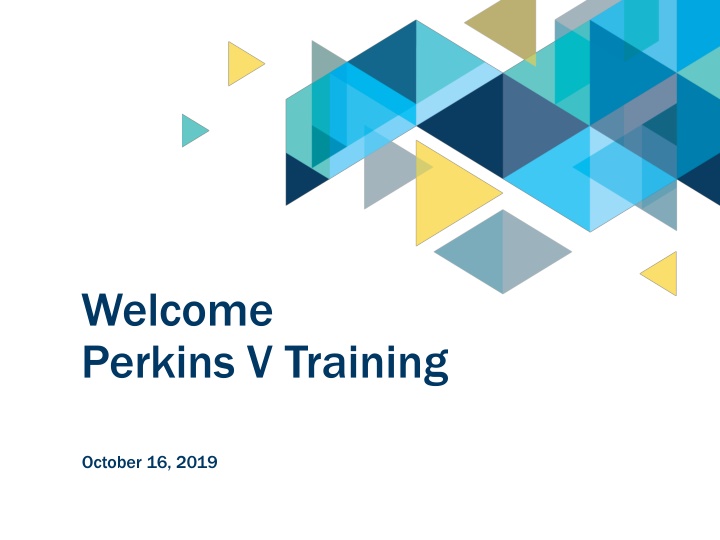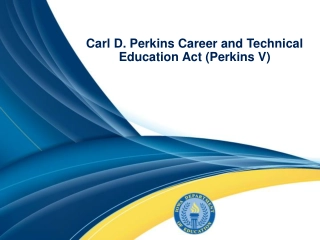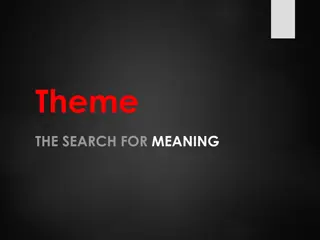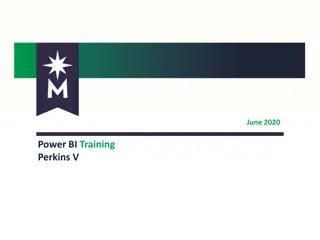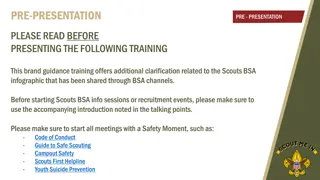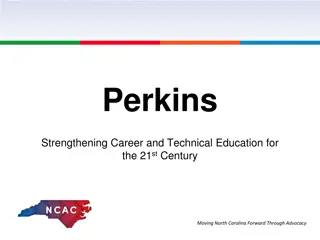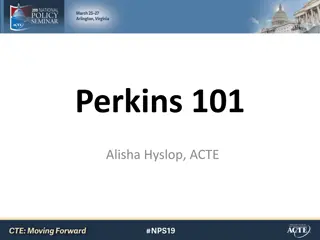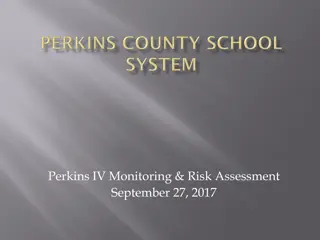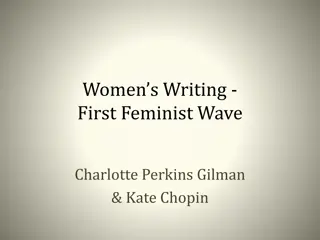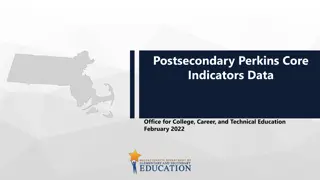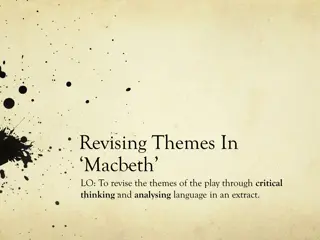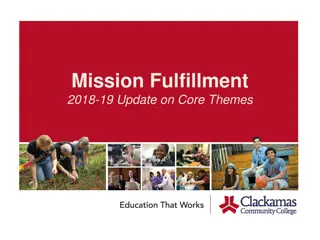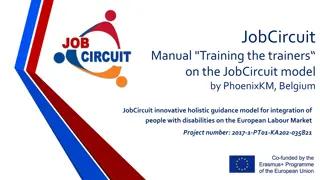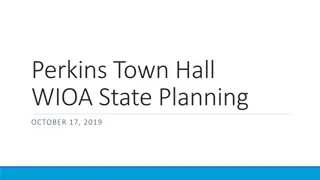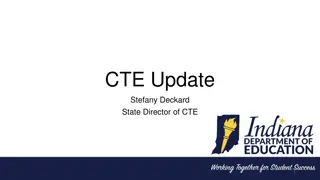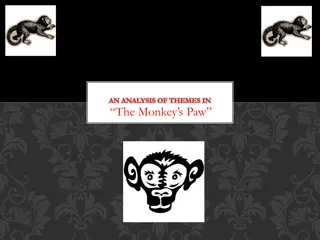Perkins V Training Overview and Important Themes
In this presentation, the Perkins V training session held on October 16, 2019 is covered comprehensively. It includes details on the new performance indicators, student data analysis, local needs assessment, and more. The key themes of equity, access, program improvement, stakeholder engagement, alignment, and innovation are highlighted. The presentation also features practice questions to test knowledge on Perkins V.
Download Presentation

Please find below an Image/Link to download the presentation.
The content on the website is provided AS IS for your information and personal use only. It may not be sold, licensed, or shared on other websites without obtaining consent from the author.If you encounter any issues during the download, it is possible that the publisher has removed the file from their server.
You are allowed to download the files provided on this website for personal or commercial use, subject to the condition that they are used lawfully. All files are the property of their respective owners.
The content on the website is provided AS IS for your information and personal use only. It may not be sold, licensed, or shared on other websites without obtaining consent from the author.
E N D
Presentation Transcript
Welcome Perkins V Training October 16, 2019
Count-down START START
Welcome! Perkins V Subcommittee Members: Cathy Alston, Green River Rachel Andre, Seattle Colleges Terry Cox, Edmonds Keeley Gant, Columbia Basin Loren Hadley, Shoreline Brian Kneidl, Peninsula Paulette Lopez, Yakima Valley Trish Newbold, Whatcom Susan Parker, Bellingham Tech. Tim McClain, SBCTC Kathy Goebel, SBCTC
What Well Cover Today Overview of Perkins V The New Performance Indicators Student Performance Data Root Cause Analysis and Developing Strategies The Comprehensive Local Needs Assessment Next Steps
Perkins 101 Test your knowledge Amaze your friends Brian Kneidl Tim McClain
Practice Question Choose your favorite music genre: A. Rock B. Hip-Hop C. Pop D. Country
Practice Question Choose your favorite dessert: A. Cake B. Pie C. Ice Cream
Which is NOT requirement and a major theme of Perkins V? NOT an accurate correlation between a A. Disaggregated performance data = equity B. Accountability indicators = program improvement C. Programs of study = alignment w/ K-12 and industry sectors D. Flexibility in use of funds = innovation E. Defense Against the Dark Arts = preparing students for non-traditional occupations within the Ministry of Magic
The Answer Is E Defense against the dark arts Important Perkins V themes Equity and Access Program Improvement Stakeholder Engagement Alignment Innovation
Which of the following was NOT Perkins V? NOT redefined in A. Program of Study B. Work-Based Learning C. Professional Development D. Size, Scope, and Quality E. CTE Concentrator F. Special Population
The Answer Is D- Size, Scope, & Quality These definitions have changed Program of Study* Work-Based Learning* Professional Development CTE Concentrator Special Population* *These definitions will be addressed in subsequent questions.
Which of the following terms/phrases are used to define Program of Study? A. Dual-credit B. Nonduplicative C. Academic and technical content D. Middle grades E. Some of the above F. All of the above
The Answer Is E - Some of the above Program of Study A coordinated, nonduplicative sequence of academic and technical content at the secondary and postsecondary level .
Which of the following is NOT component of Programs of Study? NOT a required A. State approval and cataloging B. Challenging state academic standards C. Academic and technical knowledge and skills D. Alignment with employer needs E. Multiple entry and exit points F. All of the above
The Answer Is A State approval Programs of Study should include Challenging state academic standards Academic and technical knowledge and skills (including employability skills) Alignment with employer needs Progression in specificity Multiple entry and exit points Opportunity to attain a postsecondary credential
Work-based learning is characterized by: A. Real workplace settings B. Simulated work environments C. Sustained interactions with professionals D. Alignment with curriculum and instruction E. All of the above
The Answer Is E All of the above Work-Based Learning Sustained interactions with professionals Real workplace setting or simulated environments In-depth, firsthand experiences with required tasks in the field Aligned to curriculum & instruction
Equity in meeting the needs of ALL students is a major theme in Perkins V, as evidenced by the frequent inclusion of the term Special Populations . Which of the following is NOT revision to the list of Special Populations? A. Out-of-workforce individuals B. Individuals preparing for non-traditional fields C. Homeless individuals D. Foster youth E. Youth with active-duty military parents NOT a
The Answer Is B Individuals with disabilities Individuals from economically disadvantaged families, including low-income youth and adults Individuals preparing for non-traditional fields Single parents, including single pregnant women Out-of-workforce individuals English learners Homeless individuals Youth who are in, or have aged out of, the foster care system Youth with a parent who is a member of the armed forces on active duty
The comprehensive local needs assessment (CLNA) should address which of the following Perkins V priorities? A. Equity and access B. Data-driven program improvement C. Accountability for funding D. Stakeholder engagement E. Program alignment with employer needs F. All of the above
The Answer Is F All of the above CLNA Requirements Evaluation of student performance, including special populations Description of size, scope, and quality Evaluation of program/program of study implementation Recruitment, retention, and training of educators Progress towards implementation of equal access to high-quality CTE
Your first Comprehensive Local Needs Assessment will be due: A. Winter 2020 B. Fall 2020 C. Winter 2021 D. Due? I m not due-ing it!
The Answer Is A CLNA-Light will be due Winter 2020 Internally Focused Element 1: Improving Equity and Access Element 2: Evaluation of Student Performance
The comprehensive local needs assessment is: A. A disgustingly egregious example of legislative overreach. B. A ho-hum means of loosening Carl D. Perkins purse strings. C. An invaluable opportunity to work with our partners to evaluate our programs efficacy in meeting employer needs and equitably preparing students for living-wage careers in in-demand occupations. D. The greatest thing since sliced bread because I m a data and accountability nerd.
The Answer Is C An invaluable opportunity to work with our partners to evaluate our programs efficacy in meeting employer needs and equitably preparing students for living-wage careers in in-demand occupations.
Expenditures prohibited by Perkins V include: A. Food purchases B. Direct assistance to students C. Support for students participating in CTE clubs and organizations D. Marketing and recruitment materials E. All of the above F. None of the above
The Answer Is F None of the above Required uses of Perkins funds: Career exploration & development activities Professional development for teachers, faculty, school leaders, administrators, etc Skills necessary to pursue high-skill, high-wage, or in-demand careers Integration of academic skills into CTE programs Implementation of CTE programs/programs of study Evaluations of the activities carried out with funds
Perkins V requires no less than a 25%/75% split of the state s funding between secondary and postsecondary or vice versa? A. True B. False
The Answer Is B False Current Split: 56%/44% - $12,265,098 Postsecondary - $10,056,444 Secondary 50/50 Split - $11,160,770 to Each - $1,104,328 Loss to CTC System - Average Loss of $33,464 per College The Moral: Spend Your Money! Spend Your Money!
Questions? Perkins V Brief in folders
Perkins Indicators & Big Data What s changed Carmen McKenzie Tim McClain
Perkins Indicators Broad measures of performance How well are schools and colleges preparing all students for work? Shows if state policies are improving positive outcomes for Students Employers Each state determines its performance targets
Indicator Definitions (Blue handout) Concentrator Credit Threshold Exiter Program Completion Cohort
Perkins V Indicators 1P1 Students who complete their program and do something more. 2P1 Students who complete their program. 3P1 Students preparing for non-traditional fields.
Indicator 2P1 Percent of Concentrators who received a Percent of Concentrators who received a postsecondary credential in or within 1 year of postsecondary credential in or within 1 year of program completions program completions Denominator = CTE Concentrator Cohort Numerator = Cohort with Program Completion Prog. Completion = Exit Codes 1 through Y excluding codes U, 6 and 7.
Indicator 1P1 Percent of Concentrators who, during 2 Percent of Concentrators who, during 2nd program completion do any of the following: program completion do any of the following: Remain enrolled in postsecondary education. Participate in advanced training Enter into military service Participate in a national service program (AmeriCorps) Serve in the Peace Corp Placed or retained in employment nd quarter after quarter after
Indicator 3P1 Percentage of Concentrators in CTE programs and Percentage of Concentrators in CTE programs and programs of study that lead to non programs of study that lead to non- -traditional fields. traditional fields. Denominator = cohort and enrolled in CTE programs leading to careers in non-traditional fields. (both genders) = # of students in Concentrator Numerator = # of students in cohort who represent the non-dominant gender enrolled in CTE programs leading to careers in non-traditional fields.
